Campus Guide
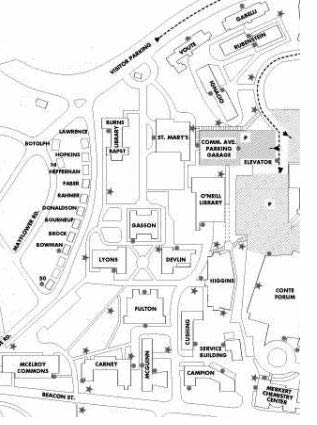
The Middle Campus was the first area to be developed on the Chestnut Hill campus. It is also the area where most of the lecture halls and classrooms are located.
Boston College was founded by the Society of Jesus in 1863 as a means of providing a college education for the children of Catholic immigrants. Originally located on Harrison Avenue in the South End of Boston, where it shared quarters with Boston College High School, the College outgrew its crowded urban setting toward the end of the 19th century.
A new location was selected, west of the city, in what was then an almost rural village of Newton called Chestnut Hill. The property purchased in 1907 overlooking the reservoir, had belonged to Amos Adams Lawrence, a wealthy textile magnate and a member of the distinguished Lawrence family. A design competition for the development of the campus was won by Charles Donagh Maginnis of the Boston firm of Maginnis and Walsh. Ground was broken on June 19, 1909, for the first of a series of handsome Gothic structures on "the Heights."
The style adopted for the buildings that would dominate the middle campus was English Collegiate Gothic. The architects felt this style would be not only suitable for the topography of the area, but also most appropriate for an academic institution with a strong religious foundation. Eventually Gasson Hall, St. Mary's Hall, Devlin Hall, and the Bapst Library became what the first university historian, Rev. Charles F. Donovan, SJ, called the "original architectural gems" of the University, and the center from which all future classroom buildings on the Middle Campus would radiate.
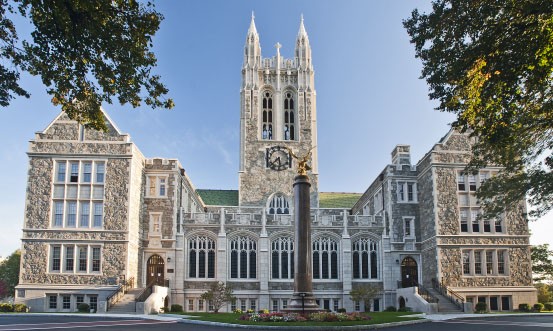
Named in honor of Rev. Thomas I. Gasson, SJ, president of Boston College from 1907 to 1914 and founder of the Chestnut Hill campus. Gasson Hall is located in the center of the Middle Campus.
Born in 1859 in Kent, England, Thomas Gasson was raised as a member of the Church of England. At the age of 13 he immigrated to the United States, where he eventually converted to Catholicism. He subsequently entered the Society of Jesus and was ordained to the priesthood in 1891. In August 1895, he was assigned to Boston College, where he taught ethics and economics until his appointment as President of the College in January 1907. It was Father Gasson who proposed that Boston College purchase the "magnificent site on Commonwealth Avenue towards Brighton."
Originally called the Recitation Building, then the Tower Building, the original Gothic structure that presides over the Heights is now named Gasson Hall in honor of its builder. The main floor contains the office of the Dean of the College of Arts and Sciences. The large front room, now called the Irish Room, was originally used as the University's assembly hall, as well as a lecture room for large classes in theology and philosophy. It currently serves as a center for special events. Across the rotunda is the original college library, whose stained glass windows show the coats of arms of the other Jesuit colleges in America. The upper floors contain classrooms large and small. Most distinctive of these is the Fulton Debate Room, whose front wall contains the names of the student winners of the annual prize debate, beginning in 1890, with space left for future winners through the year 2014.
The rotunda on the first floor, surrounded by murals of notable Jesuits and statues of four Jesuit saints, contains a white marble statue of the Archangel Michael overcoming Lucifer. In the great Gothic tower of Gasson Hall, four bells — each named after a prominent Jesuit — chime on the quarter hour.
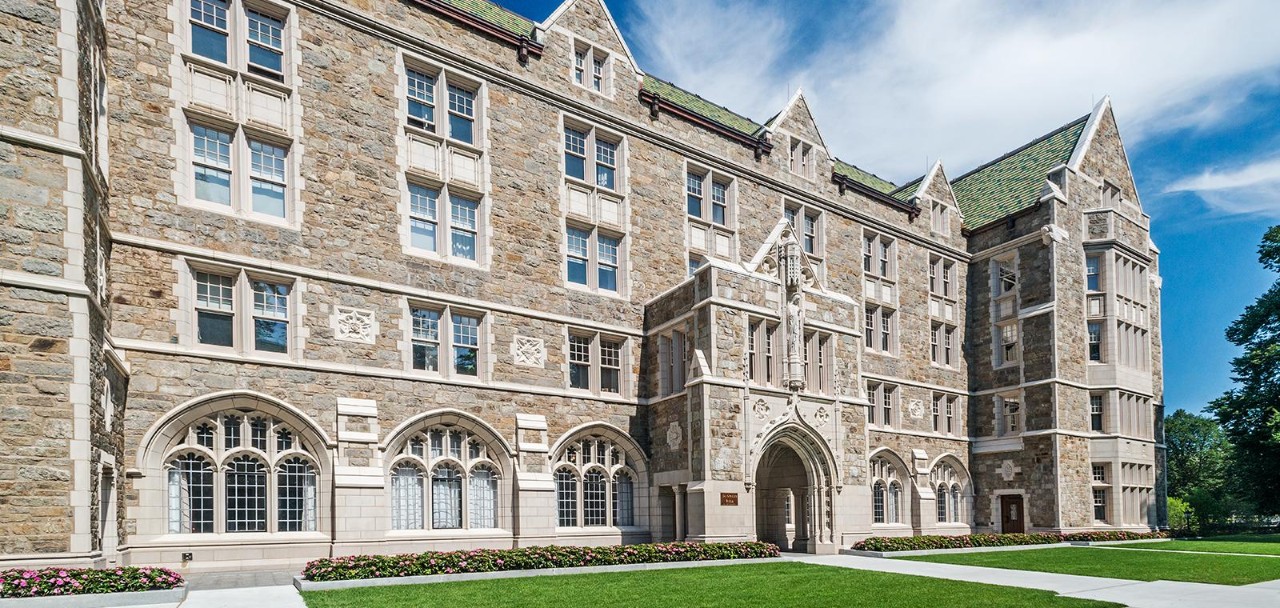
Named after St. Mary's Church in Boston, to which the Jesuits were called in 1847, St. Mary's Hall is located across Linden Lane from Bapst Library.
St. Mary’s Hall was the second building on the campus, opened in 1917 as a residence for the Jesuit faculty and staff. With its graceful arches of Gothic windows encircling the lower floors, the new building was designed to conform to the impressive architectural plans for the University. St. Mary's upper three floors contain living quarters for the Jesuits; the first floor is given over to the Jesuits' dining room, common room, visitors' parlors, and a small library. The north end contains St. Mary's Chapel, a "Gothic gem," as one Jesuit described it, with a marble altar, oak pews, a carved oak ceiling, and a choir loft. The south wing of the building, added in 1930, provided a cloister walk enclosing a small garden; it is now home to the Woods College of Advancing Studies.
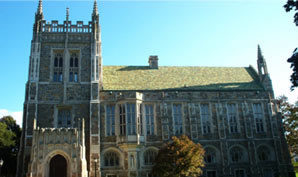
Named in honor of Rev. John Bapst, SJ, first president of Boston College, Bapst Library is located on Linden Lane, opposite St. Mary’s Hall.
John Bapst was born in Switzerland in 1816 and, after graduating from the Jesuit College at Fribourg, joined the Society of Jesus. He came to the United States, where he worked among the Native peoples of Maine. In October 1854, a nativist "Know-Nothing" mob tarred and feathered the priest, permanently impairing his health. On July 10, 1863, after Boston College was officially incorporated, the trustees elected Father Bapst the first president of Boston College.
Bapst Library was designed by Charles Donagh Maginnis in the English Collegiate Gothic style and was opened in 1928. The Mary Elizabeth Ford Memorial Tower, resembling Merton Tower at Oxford University, rises at the northern end of the building. Extensive renovations during the mid-1980s transformed the entire north wing of the building into a major research library. The Burns Library, dedicated to the memory of alumnus Judge John J. Burns (`21), provides a state-of-the-art facility that houses archives, rare books, and special collections.
The main entrance to the Bapst Library is located at the southern end of the building. Above the central doors of the south porch is the sculptured figure of Mary, Seat of Wisdom, flanked by prophets and the four Evangelists. The spacious first floor of the library was originally used as the University auditorium. With the renovations of the 1980s, however, the first-floor area was converted to what is known as the Kresge Reading Room, an area of quiet carrels that provides one of the choicest study spaces on campus. The main reading room on the second floor is named for Thomas Gargan, a prominent local lawyer, and features stained glass windows depicting the various academic disciplines.
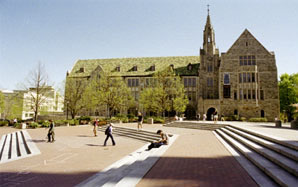
Named for Rev. William J. Devlin, SJ, 15th president of Boston College, Devlin Hall is one of four buildings comprising the "Quad" in the Middle Campus.
Born in New York City in 1875, William Devlin spent most of his youth attending schools in Europe. He planned to enter the Society of Jesus in England, but when his father died, he returned to America and entered the Maryland Jesuit Province. He taught for many years at Boston College, and in 1914 he was named Dean, holding the position until he was named President in 1919.
Seeing the need for a classroom building for the sciences, Father Devlin launched a major fund drive during spring 1921. Ground was broken for the new Gothic structure in June 1921, and the first classes in chemistry, physics, and biology were held in Devlin Hall 1924. The building served for many years as the center for scientific research at Boston College. Devlin Hall is also the location of the Undergraduate Admission Office.
As the various fields of the sciences grew more numerous, however, and as the need for research laboratories became more pressing, additional science buildings were necessary. Higgins Hall, housing biology, physics, and earther sciences, opened in 1966, followed by Merckert Hall for chemistry in 1991.
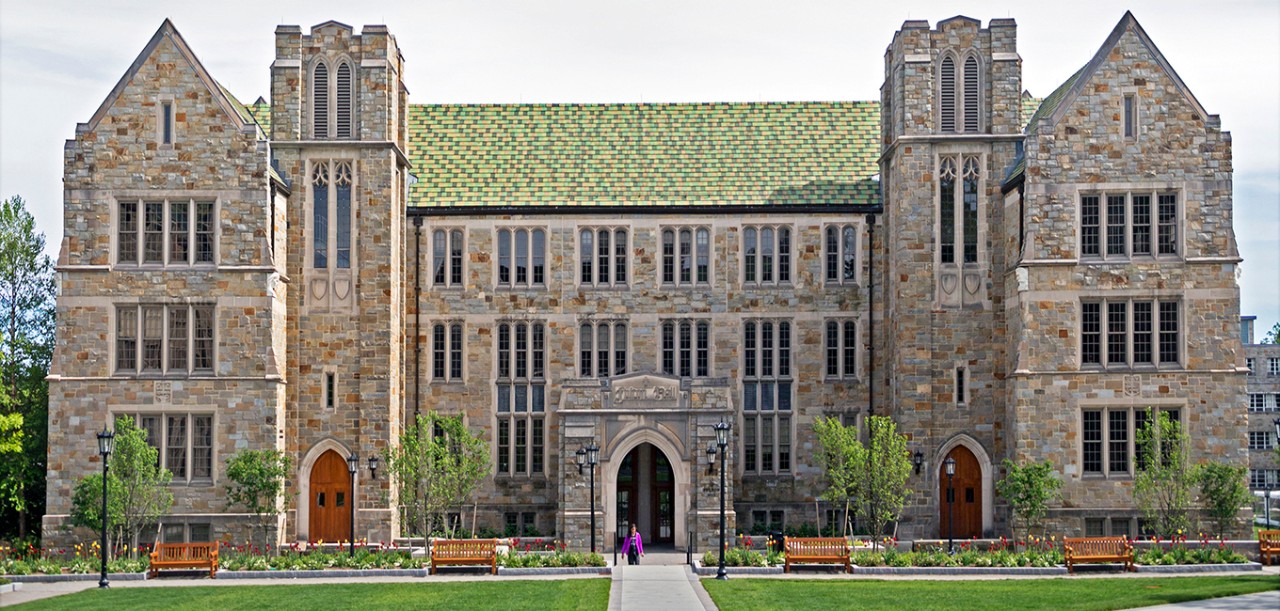
Fulton Hall forms the southern end of the Quad at the center of the Middle Campus. It is named for Rev. Robert Fulton, SJ, the first dean of Boston College and the only person to have served as president twice, from 1870 to 1880 and again from 1888 to 1890.
Born in Alexandria, Virginia in 1826, Robert Fulton attended Georgetown University and was ordained as a Jesuit priest in 1857. He was assigned to Boston College as “Prefect of Studies” when it first opened for classes in September 1864. The "animating spirit" of the new institution, Father Fulton oversaw the establishment of the academic program.
In March 1938, Rev. Willam J. McGarry, SJ, president of Boston College, authorized a four-year undergraduate program leading to a degree in business administration. Classes were first held on Newbury Street in downtown Boston and then moved to O'Connell House (formerly the Liggett Estate) on the Chestnut Hill Campus.
In June 1947, Rev. William L. Keleher, SJ authorized the construction of a building named after Father Fulton to house the College of Business Administration. Height restrictions were placed on Fulton Hall so that it would not block the view of the Gasson Hall Tower, which gave the new building a rather squat appearance. In the 1990s, however, a major renovation gave both graceful height and new Gothic splendor to Fulton Hall, which now houses the Carroll School of Management, named in honor of Wallace E. Carroll (1928), a generous alumnus.

Named after Rev. Charles W. Lyons, SJ, 14th president of Boston College, Lyons Hall completes the Quad.
Born in Boston on January 31, 1869, Charles Lyons attended the public schools of the city and graduated from Boston English High School. He entered the Society of Jesus in August 1904 and taught metaphysics at St. Francis Xavier College in New York and Boston College. After serving as president of Gonzaga College in Washington, DC, and St. Joseph's College in Philadelphia, Father Lyons was named president of Boston College in 1914 and served in that capacity until 1919.
Following World War II, as enrollments surged, more classroom space was desperately needed. Built in the Gothic style, Lyons Hall was completed in July 1951, with most of the classrooms large enough to accommodate "philosophy classes." Over time, much of the space has been converted to offices. The Office of Student Services occupies the first floor. The Music Department and the University Chorale occupy the fourth floor. Lyons Hall also boasts a cafeteria in the basement large enough to seat 500 students.

Named for Saint Edmund Campion, a pioneering English Jesuit and martyr.
Born in London in 1539, he was caught up in the religious turmoil of the Reformation. Joining the Jesuits on the continent, he returned to England to try to return the country to loyalty to Rome, but he was captured, tortured, and executed.
Campion Hall was opened in 1955 and is home to the Carolyn and Peter (1965) Lynch School of Education and Human Development. The school of education was established in 1951 to meet the expanding needs of the public and parochial school systems in the greater Boston area. This school, together with the William Connell (1959) School of Nursing, established in 1947, were the first entirely coeducational schools at Boston College.
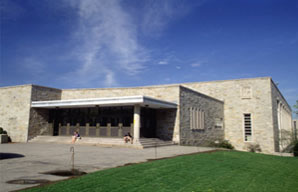
Located at the far end of the Middle Campus, McElroy Commons stands at the intersection of Beacon and Hammond Streets and College Road. It is named in honor of Rev. John McElroy, SJ, the founder of Boston College.
John McElroy was born in County Fermanagh, Province of Ulster, on May 14, 1782, and followed an older brother to American in 1803. He became a Jesuit lay brother at Georgetown College and in 1815, at the age of 33, he was allowed to study for the priesthood. He was ordained two years later.
Father McElroy served as pastor and preacher in Maryland, and he served as a chaplain in the Mexican-American War before coming to Boston in 1847 to become pastor of St. Mary's Church in the North End. Committed to opening a "college in the city" for the sons of immigrants, Father McElroy worked for 16 years to acquire the funds, the property, and to supervise construction of the original college buildings.
McElroy Commons was dedicated on November 9, 1961. It was designed as a multipurpose student–faculty center in order to meet the expanding space needs of Boston College during the phenomenal growth of its student body and faculty in the decades after World War II. It contains two dining rooms, a faculty dining room, a post office, and a book store, in addition to a number of rooms for student organizations and cultural activities.
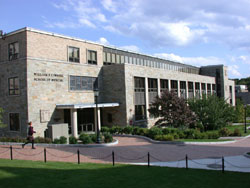
Named in honor of Richard Cardinal Cushing, sixth Archbishop of Boston, Cushing Hall is located across from Fulton Hall, with which it makes up the farther end of Middle Campus.
A native of South Boston, Richard Cushing graduated from Boston College High School and attended Boston College for two years before going to St. John's Seminary to study for the priesthood. Ordained in 1921, Cushing became so successful in his endeavors to promote foreign missions that he was named Auxiliary Bishop of Boston. In 1944 he succeeded Cardinal O'Connell as Archbishop of Boston, and in 1958 he was elevated to the rank of Cardinal by Pope John XXIII.
During much of his public life, Cushing was afflicted by a series of illnesses that endangered his life and threatened to end his episcopacy. In gratitude to the nurses, whose hard work and medicinal skills had eased his sufferings and prolonged his life, he urged Boston College to construct a new building on the Chestnut Hill campus for its School of Nursing, and personally contributed nearly a million dollars for the project. The Cardinal himself presided at the dedication ceremonies on March 25, 1960.
Cushing Hall houses the offices of the dean and faculty members of the School of Nursing. In 2001 the School of Nursing was named in honor of William F. Connell ('59) in appreciation of his generous gift. Cushing Hall also is home to the school's counseling services, a chapel dedicated to St. Catherine of Siena, the University Infirmary, and a variety of classrooms and lecture halls. The building and its furnishings were a gift from Cardinal Cushing, and the dedicatory plaque at the entrance was designed by Allison Macomber, artist-in-residence at Boston College.
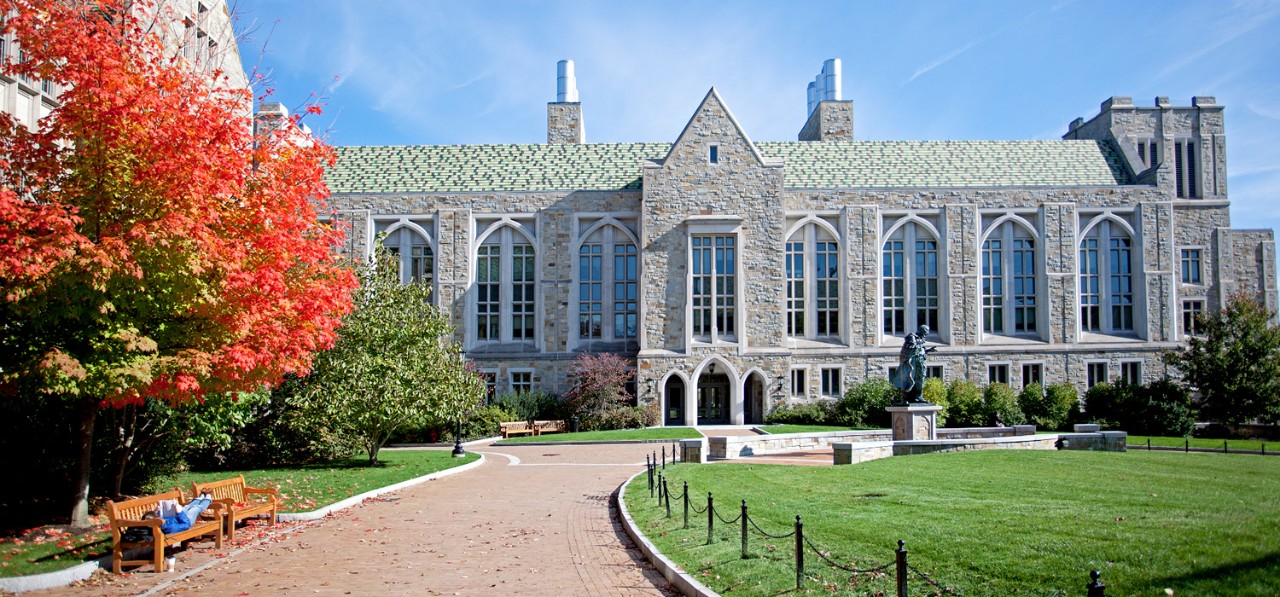
Named for John P. Higgins, a longtime associate of Stephen P. Mugar, whose philanthropy supported construction of the building.
Interest in space programs, medical research, and more-advanced graduate studies was increasing during the 1960s. It became obvious that Devlin Hall, the original science building, could no longer supply the classroom and laboratory spaces needed for serious study in the sciences. Father Michael P. Walsh, SJ — president of Boston College and trained as a biologist — broke ground for the new science building on March 29, 1965. Higgins Hall would become home to the Biology and Physics departments, which moved out of Devlin Hall.
After 30 years, it became necessary to update the scientific facilities of these departments, as well as to modernize Higgins' electrical systems and provide additional teaching and research laboratories. Therefore, in 1997 Boston College launched a major renovation and expansion of Higgins in order to meet current standards for scientific teaching and research. As part of this renovation, an addition was built across the front of the building, with an atrium created between the addition and the existing structure; this addition brought the building into harmony with the prevailing Collegiate Gothic style of the rest of the Middle Campus.
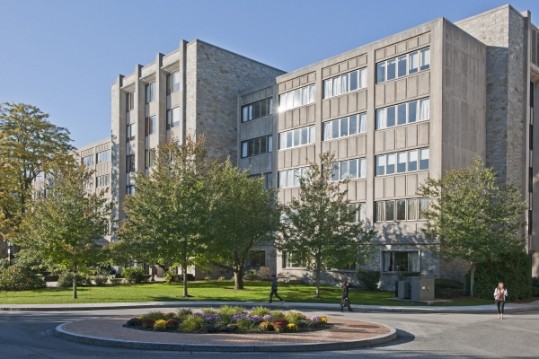
Named in honor of two Boston College faculty members Rev. Walter McGuinn, SJ, and his brother, Rev. Albert McGuinn, SJ, McGuinn Hall is located behind and below the incline from Carney Hall.
Father Walter McGuinn was convinced there was a need in the Boston area for professionally trained social workers who could view social problems in the light of Catholic social principles. With the idea of starting a school of social work at Boston College, he engaged in graduate studies at Fordham University in New York; in 1935 he was awarded a Ph.D. degree in Social Work. In May 1936, a Graduate School of Social Work at Boston College was opened. The first classes were held in September 1936 at the school's quarters at 126 Newbury Street in downtown Boston.
Father McGuinn died suddenly on April 1, 1944, and he was succeeded by Dorothy Book, a faculty member; she was the first woman to be a dean of any of the schools of Boston College. In 1968, the building was opened and dedicated to the social sciences. It would be named for Father Walter McGuinn and for his brother, Father Albert McGuinn, who served for many years as chairman of the Chemistry Department.
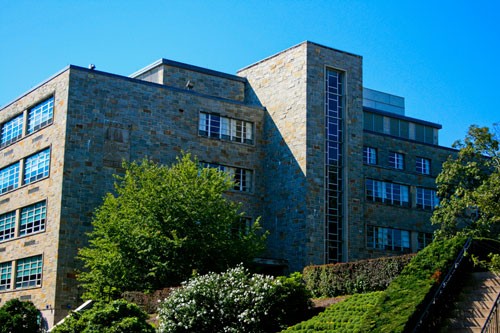
Named in honor of Andrew Carney, a 19th-century Boston merchant and philanthropist who was an early benefactor of Boston College, Carney Hall is located along Beacon Street between McElroy Commons and McGuinn Hall.
A native of County Cavan, Ireland, Andrew Carney came to America at the age of twenty. He worked as a tailor and, through careful saving, became a partner in Carney & Sleeper, Clothiers. He was one of the originators of the First National Bank of Boston, as well as of the John Hancock Insurance Company. A loyal friend to the Jesuits and the new Immaculate Conception Church in the South End, upon his death on April 4, 1864, Andrew Carney left a generous bequest of some $25,000 worth of securities that helped launch Boston College as a viable institution.
The sudden and rapid extension of the lay faculty at Boston College after World War II quickly outran office space. The Jesuits had their own rooms in St. Mary's Hall; the new buildings constructed for the professional schools — Law, Business, Education, Nursing — provided office space for their members. The faculty of the College of Arts and Sciences, however, had only makeshift arrangements.
Under Rev. Michael P. Walsh, SJ, president of Boston College, ground was broken in April 1963 for a faculty office building called Carney Hall. A four-story, functional structure arranged in a square L-shape, Carney provided office space for most of the Arts & Sciences departments. As the faculty continued to grow, the University launched a building program to create a much more spacious faculty office building on the Lower Campus below the O'Neill Library.
Named after Thomas P. ("Tip") O'Neill, Jr., Boston College alumnus ('36), Congressman from Massachusetts, Speaker of the United States House of Representatives, the library is located next to Devlin Hall.
Since its construction in 1928, Bapst Library had served as the main library for Boston College. By the 1970s, however, it was clear that Bapst could no longer meet the needs of a student body that numbered well over ten thousand. Early in his administration as president, Rev. J. Donald Monan, SJ made a new library building a major priority
After preliminary studies, in 1978 the Architects Collaborative was commissioned to design a library on the hillside across from Gasson Hall. On October 14, 1984, at a ceremony held in the open plaza facing the structure, the new library was formally dedicated, in honor of an illustrious alumnus, Thomas P. O'Neill, Jr. ('36), Speaker of the House of Representatives.
Built with a warm Rockville granite from Minnesota, the O'Neill Library is a massive structure, large enough to hold a million books. Three of its five stories are situated on the downhill side of the site, while only three stories rise above eye level on the crest of the hill. Thus the O'Neill does not compete in height with Gasson, Devlin, or St. Mary's Halls; nor do its clean, simple lines distract from the Gothic beauty of the original buildings. Yet the building provides a spectacular view of the Boston skyline.
The interior of the library is warm and welcoming, with wall-to-wall carpeting and natural oak furnishings. Video display terminals have replaced the old card catalogs, and a modern computer system manages all library functions.
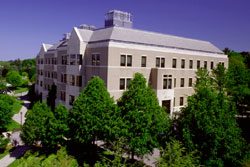
Named in honor of Eugene F. Merkert, founder and president of the food brokerage business Merkert Enterprises and a generous contributor to the building, Merkert Center is located at the far end of Middle Campus, near Conte Forum and Alumni Stadium, on Beacon Street.
Boston College's Chemistry Department was originally housed in Devlin Hall, together with the other science departments of the University. When Higgins Hall was completed in 1966, the Departments of Physics and Biology moved into the new building, but Chemistry remained in Devlin Hall.
The Chemistry Department is now housed in the 109,000-square-foot Merkert Chemistry Center, which opened in fall 1991. The building contains modern laboratories, classrooms, and computer facilities; it is regarded as a model for chemistry departments nationwide and as a standard of laboratory innovation and excellence. Each year, a distinguished scientist visits the department as the University Lecturer and offers an annual seminar series attended by outstanding visiting scientists.
To the east of Boston College's Middle Campus of is the Lower Campus, the site of several of the University's major athletic facilities, as well as of a number of undergraduate dormitories and two large parking garages.
The original Lawrence Farm in the suburb of Newton overlooked the Chestnut Hill Reservoir and commanded a superb view across the water over Brighton and Brookline toward Boston. In 1949, after the reservoir had been filled in, the resulting plateau provided a natural setting for the expansion of the University's athletic programs.
From a series of small, makeshift facilities on the Middle Campus and a modest football field along College Road, Boston College was able to develop major recreational facilities for its varsity sports teams as well as for its general student body. The Lower Campus also provided space for the University to build a theater, as well as additional high-rise dormitories for a growing number of resident students.

The first stadium erected when Boston College moved to the Heights in 1915 was situated on the Main Campus, running along what is now College Road. This modest stadium seated 5,000 spectators. In 1932, it was expanded to seat 22,000, but the success of BC football teams during the 1930s and '40s required larger facilities.
From 1937 to 1939, many BC football games were played at Fenway Park. After World War II, from 1946 to 1952, the games moved to Braves Field, the home of the former Boston Braves baseball team. By the 1950s, however, BC was faced with a difficult decision: Give up football, or build a new stadium.
Responding to alumni pressure, in 1957 Rev. Joseph Maxwell, SJ, President of Boston College, announced a $250,000 Alumni Fund Drive to build a new football stadium on the Beacon Street end of what had been the small reservoir area. The fund drive was a success, and the new Alumni Stadium was dedicated in September 1957.
Over the years, a series of improvements have been made to the facility. It was renovated in 1971, and again in 1988; the latter effort included the installation of an AstroTurf field. In the summer of 1994, a major renovation provided Alumni Stadium with a handsome new brick exterior, as well as 12,000 more seats, bringing its total seating capacity to 44,500. In addition to athletic events, Alumni Stadium also hosts annual Commencement exercises, which draw world-renowned speakers to the Boston College campus.
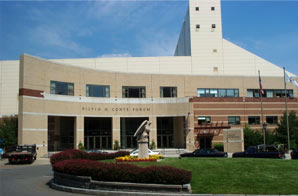
Inspired by the decision to build a new football stadium in 1957, BC alumni supported the construction of a gymnasium containing a basketball court as well as a regulation-size hockey rink. Located along Beacon Street, south of the Middle Campus, the gymnasium was named the Roberts Center after Mr. and Mrs. Vincent P. Roberts, generous benefactors of the College. The hockey rink, built parallel to the football stadium, was called McHugh Forum after Fr. Patrick J. McHugh, SJ, a popular BC dean.
In 1988 the Silvio O. Conte Forum was built on the Lower Campus to provide larger and more-modern facilities. It was named after U.S. Representative Silvio O. Conte ('49), 30-year veteran Massachusetts congressman and former BC Football letterman. The building, which is connected to Alumni Stadium, provides seating capacity of 8,500 for basketball and 7,784 for hockey.
Conte Forum is now the main area for men's and women's ice hockey and basketball, as well as the location of the athletic offices for most varsity sports at Boston College. The forum also accommodates numerous conferences, concerts, and other entertainments, including the annual scholarship fundraiser Pops on the Heights, featuring the Boston Pops Orchestra.
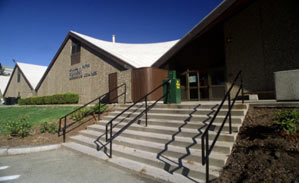
The student recreation complex is named for William J. Flynn ('39), director of athletics at Boston College from 1957 to 1990, and is located across from Conte Forum.
Captain of the Boston College football team in his senior year, Bill Flynn returned to the Heights in 1948 to become a member of the mathematics department, an assistant coach, and alumni secretary before becoming director of athletics. Flynn, who enjoyed a national reputation in athletic circles, served two terms as president of the NCAA. He supervised most of the University's modern athletic facilities on the Lower Campus, including Alumni Stadium, Conte Forum, and the Recreational Complex that bears his name.
In 1971, Flynn suggested a $25 student recreation fee to help finance a recreational complex that would serve the entire student body, with Boston College supplying the remainder of the money. Opened in 1972, the "Plex," as it came to be known, is built of pre-cast concrete with a hyperbolic roof of plywood and laminated beams. It includes an indoor track, an eight-lane swimming pool, saunas, basketball courts, squash courts, handball courts, a batting cage, a golf driving cage, an area for gymnastics, and facilities for aerobics and weight training. Adjacent to the complex are six outdoor tennis courts.
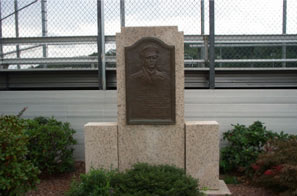
BC's baseball field is located on the east end of the Lower Campus and bounded by Beacon Street, Thomas More Drive, and Alumni Stadium. It is named in honor of Commander John J. Shea, USN, Boston College Class of 1918, who lost his life during World War II when the aircraft carrier USS Wasp was sunk by enemy action. Commander Shea's "Letter to Jackie," addressed to his young son John Richard Shea ('58), was one of the most moving personal correspondences to come out of World War II. On May 21, 1961, a bronze plaque was erected to commemorate the BC war hero.
Before World War II, collegiate baseball was a very popular varsity sport at most American colleges, and the games regularly attracted large numbers of fans. In 1923, for example, some 30,000 spectators crowded into Boston's Braves Field to watch the baseball game between Boston College and Holy Cross. More space was obviously needed for baseball facilities at the University.
As Roberts Center had been built to accommodate more spectators for basketball, and McHugh Forum for hockey, in the the mid-1950s the baseball diamond was moved from its original location on the Upper Campus to the large area on the BC side of the reservoir, and the field named for Commander Shea. The diamond was later named after Eddie Pellagrini, former infielder for the Boston Red Sox, who served as head baseball coach at Boston College from 1958 to 1988.
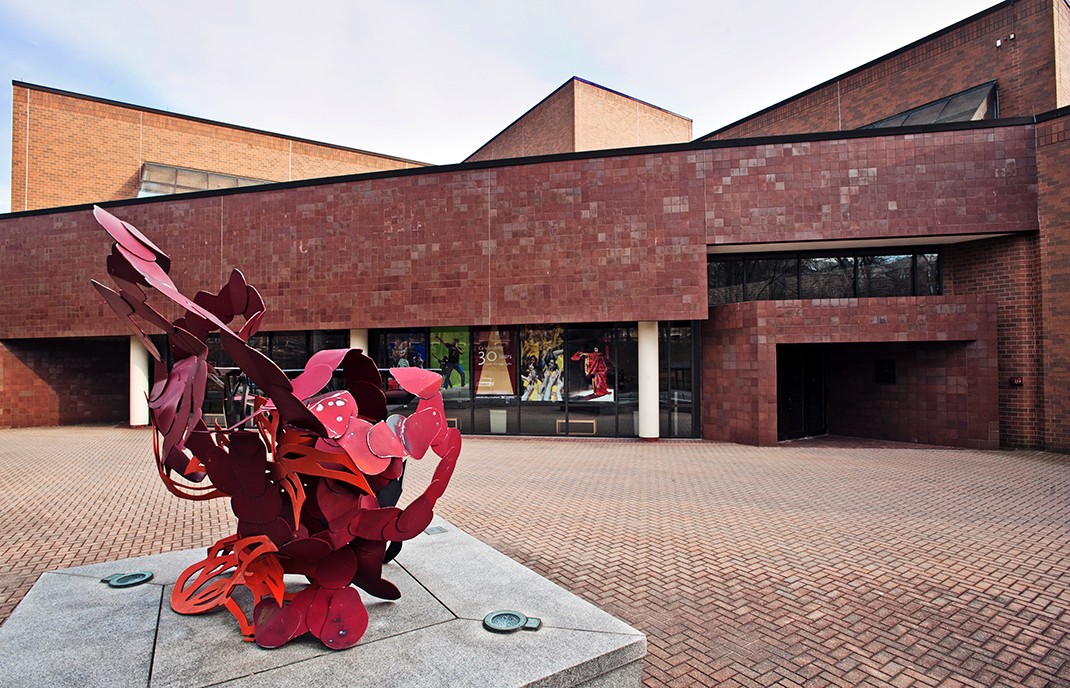
BC's theater complex is named for E. Paul Robsham, Jr., a Boston College student in the Class of 1986 who died in a tragic automobile accident in the summer of 1983. The Robsham Theater is located on the Lower Campus, just off St. Thomas More Drive, across from the main parking garage and in close proximity to the Flynn Recreational Complex and several student dormitories.
The Dramatics Society has had a long and distinguished history at Boston College, in keeping with the 400-year-old Jesuit tradition of promoting the performing arts as an integral part of a liberal education. In 1947, after World War II, the dramatic arts program was reorganized and enlarged into the School of Dramatics and Expressional Arts. In the ensuing years, under a series of outstanding directors, the Society acquired a national reputation, despite its lack of a suitable home on campus for its ambitious productions.
Architectural plans were undertaken for the construction of a theater complex at BC. On May 19, 1978, comedian Bob Hope gave a benefit performance to launch a fundraising campaign for a new $5 million University theater. The theater opened to a black-tie audience on October 30, 1981, with a production of the musical Camelot. Four years later, on the evening of October 25, 1985, another audience watched quietly as the parents of E. Paul Robsham, Jr. unveiled the plaque to their son's memory, dedicating the Robsham Theater in his name.
The main theater seats 600 people; the center also contains smaller theaters as well as several classrooms. In addition to a schedule of dramatic, dance, and musical performances, Robsham frequently hosts visiting guest speakers, conferences, political debates, readings, and academic symposia.
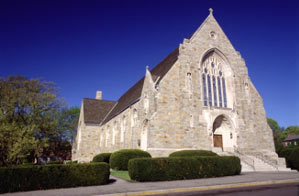
In October 1926, William Henry Cardinal O'Connell created the parish of St. Ignatius Loyola, named after the founder of the Society of Jesus, to serve the Chestnut Hill area. At the same time, he designated the small chapel in St. Mary's Hall and the large auditorium on the south side of the Bapst Library to serve together as a temporary church for the new parish. Care of the parish was assigned to the priests of the Jesuit community of Boston College.
In 1951, construction of the Gothic church of St. Ignatius Loyola was completed on Commonwealth Avenue near Lake Street. The church provides an active center of parish life for residents of the Chestnut Hill area, as well as for Boston College students, who often attend the church not only for regular Masses but also for student retreats and sacred concerts.
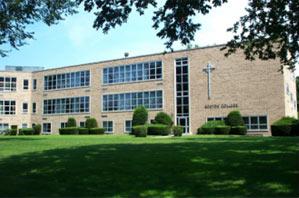
More Hall, located on Commonwealth Avenue across from St. Ignatius Church, was named for Sir Thomas More (1478–1535), lawyer and martyr, first layman to be Lord Chancellor of England.
The Boston College Law School, founded in 1929, had several locations in downtown Boston until 1952, when the decision was made to move the school to the Chestnut Hill campus. The College acquired from the City of Boston a parcel of land along Commonwealth Avenue opposite the MTBA Station. On this site was built St. Thomas More Hall, a low-lying three-story building designed by Maginnis and Walsh and dedicated in November 1954. It was the home of the Boston College Law School for the next 20 years, until 1975, when it moved to its current location on the Newton Campus.
After the Law School moved out, More Hall was converted to other purposes, mostly related to the financial management of the University. Currently, the building houses the offices of the University Treasurer, the offices of Human Resources, and the University's Office of Development.
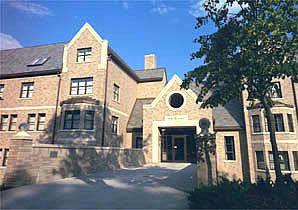
In addition to athletic complexes and recreation facilities, the Lower Campus is also home to a number of undergraduate student dormitories. Starting at the Main Gate at the top of Commonwealth Avenue and going down to Lake Street are several recent additions:
At the crest of the hill is Vouté Hall, named after the late University trustee William J. Vouté and his wife, Mary Jane. The next dormitory is Gabelli Hall, named after Mario Gabelli, a benefactor to the University. Both structures are apartment-style residence halls, completed in 1988 and providing space for 384 upperclassmen. Seventeen townhouses are unique features of these halls; each two-bedroom apartment has a full kitchen, a dining room, a living room, and a full bath.
To the south of Vouté and Gabelli, on the slope behind St. Mary's Hall, is a series of student residences overlooking the Lower Campus. Built in 1973 of buff brick and limestone, these residences actually consist of four units, Ignacio Hall A & B and Rubenstein Hall C & D. This air-conditioned apartment complex — each apartment completely furnished with two or three bedrooms, baths, living room, dining room, and kitchen — houses 725 students.
In October 1990, the A & B residence was named Ignacio Hall, attaching the name of Ignatius Loyola, founder of the Society of Jesus, to the memory of the six Jesuit martyrs and their two co-workers who were assassinated in 1989 in El Salvador. The C & D residence was named Rubenstein Hall in honor of Lawrence and Anne Cable Rubenstein, benefactors of the University.
The Office of Residential Life and the Boston College Police Department are located in the Lower Campus Administration Building
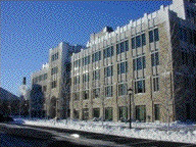
Located on the hillside east of O'Neill Library is a 155,000-square-foot structure that functions as a multipurpose administration building. In addition to serving as the headquarters of the BC Police Department and the Office of Residential Life, it also houses the Office of the Dean for Student Development.
The Administration Building also provides space for a variety of administrative offices, a bookstore annex, and a dining service facility known as the Hillside Café.
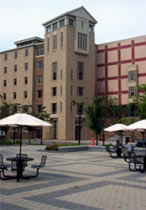
90 St. Thomas More Drive was completed in the fall of 1993, as was Vanderslice Hall, named for the parents of Thomas A. Vanderslice ('53), former Chairman of the Boston College Board of Trustees. These suite-style residence halls consist of four-, six-, seven-, and eight-person suites, each with a furnished lounge and kitchen area. They house approximately 750 male and female students, mostly sophomores and juniors. The units also provide a game room, an exercise room, music rooms, libraries and study rooms.
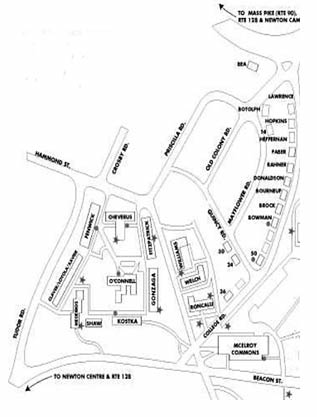
The Upper Campus is the location of 13 residential halls, housing approximately 150 students each, normally freshmen and sophomores. These are standard residence halls, with double and triple student rooms along a central corridor. Each room is wired for cable TV, DSL cable internet access, and a phone for each person.
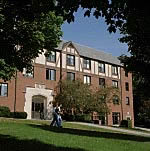
Starting at the intersection of Beacon Street, Hammond Street, and College Road, there are three student residences along the east side of Hammond Street:
Roncalli Hall
1964
Named for the Blessed Angelo Giuseppe Roncalli (1888–1963) who became Pope John XXIII, the Pope who presided over the Second Vatican Council.
Welch Hall
1964
Named for Rev. Edward Holker Welch, a member of the original Board of Trustees of Boston College. Welch came from a prominent Boston family and was received into the Catholic Church, along with his Harvard classmate, Joseph Coolidge Shaw, by Bishop John B. Fitzpatrick.
Williams Hall
1964
Named for Rev. John J. Williams, who served from 1866 to 1907 as fourth Bishop of Boston and first Archbishop of the Archdiocese of Boston.
Along the west side of Hammond Street are two student residences:
Gonzaga Hall
1957
Named for St. Aloysius Gonzaga (1568–1591), a young Italian nobleman who became a Jesuit scholastic but died during the plague of 1591. He is regarded as the patron saint of young people. On the south terrace of Gonzaga Hall is St. Joseph's Chapel, which serves the resident student population. The timbered screens and hammered aluminum altar were designed by Ken Ireland. The painting of the head of Christ is the work of Frank V. Brow ('34).
Fitzpatrick Hall
1959
Named for John Bernard Fitzpatrick, who served as third Bishop of Boston from 1846 to 1866. It was Bishop Fitzpatrick who encouraged Fr. John McElroy to create the "college in the city" that eventually became Boston College.
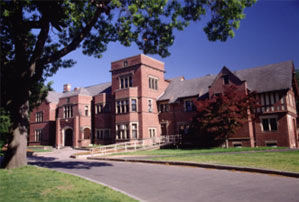
In the center of the Upper Campus is O'Connell House, named for William Henry Cardinal O'Connell, a member of the Boston College Class of 1881, fifth Bishop of Boston, second Archbishop, and first Cardinal. The building was originally constructed in 1895 by the Storey family on the model of Gwydr Hall in Wales. Later it became the estate of Louis Kroh Liggett, whose family occupied it from 1916 until 1937, when it was donated to the Archbishop of Boston. In 1941, Cardinal O'Connell made a gift of the estate, together with nine acres of land, to his alma mater.
During the early 1940s, the Liggett Estate was converted into classrooms for the new College of Business Administration, while a quadrangle of stables and carriage houses in the rear was used for athletic offices and dressing rooms. As more buildings became available, O'Connell House was used as a residence facility before being turned into a center for student entertainment, cultural events, and social functions.
South of O'Connell House are three more student residences of different styles:
Kostka Hall
1957
Named for St. Stanislaus Kostka, SJ (1550–1568). Born in Poland, Kostka entered the Society of Jesus at the age of seventeen and died a year later. His outstanding spirituality and his special devotion to the Virgin Mary earned him the designation of patron saint of religious novices.
Shaw House
1962
Named for Rev. Joseph Coolidge Shaw, SJ. Descendant of a prominent Boston family and related to many other such families, Shaw was a Harvard graduate who traveled extensively through Europe. He became a Catholic while visiting Rome. Returning to America, Shaw was ordained to the priesthood in 1847; he later decided to enter the Society of Jesus. In 1851, after only six months in the order, he died of tuberculosis. His will, leaving a gift of 1,600 books, formed the nucleus of the Boston College library.
Medeiros Townhouses
1971
Named after Cardinal Humberto Medeiros, who served from 1970 to 1983 as seventh Bishop of Boston, fourth Archbishop, and third Cardinal. Modernistic in style, these small townhouses were originally designed by architect Hugh Stubbins to provide 98 beds for students from O'Connell House.
Named for Rev. Joseph Coolidge Shaw, SJ. Descendant of a prominent Boston family and related to many other such families, Shaw was a Harvard graduate who traveled extensively through Europe. He became a Catholic while visiting Rome. Returning to America, Shaw was ordained to the priesthood in 1847; he later decided to enter the Society of Jesus. In 1851, after only six months in the order, he died of tuberculosis. His will, leaving a gift of 1,600 books, formed the nucleus of the Boston College library.
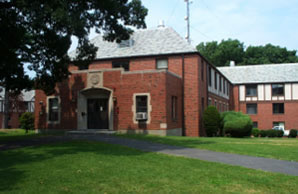
On the north side of O'Connell House is Cheverus Hall. It is named for Jean Lefebvre de Cheverus, a refugee from Revolutionary France who served as first Bishop of Boston from 1808 to 1823 for the town's first Roman Catholic community. He later returned to France to become Archbishop of Bordeaux; before his death, he was named to the College of Cardinals.
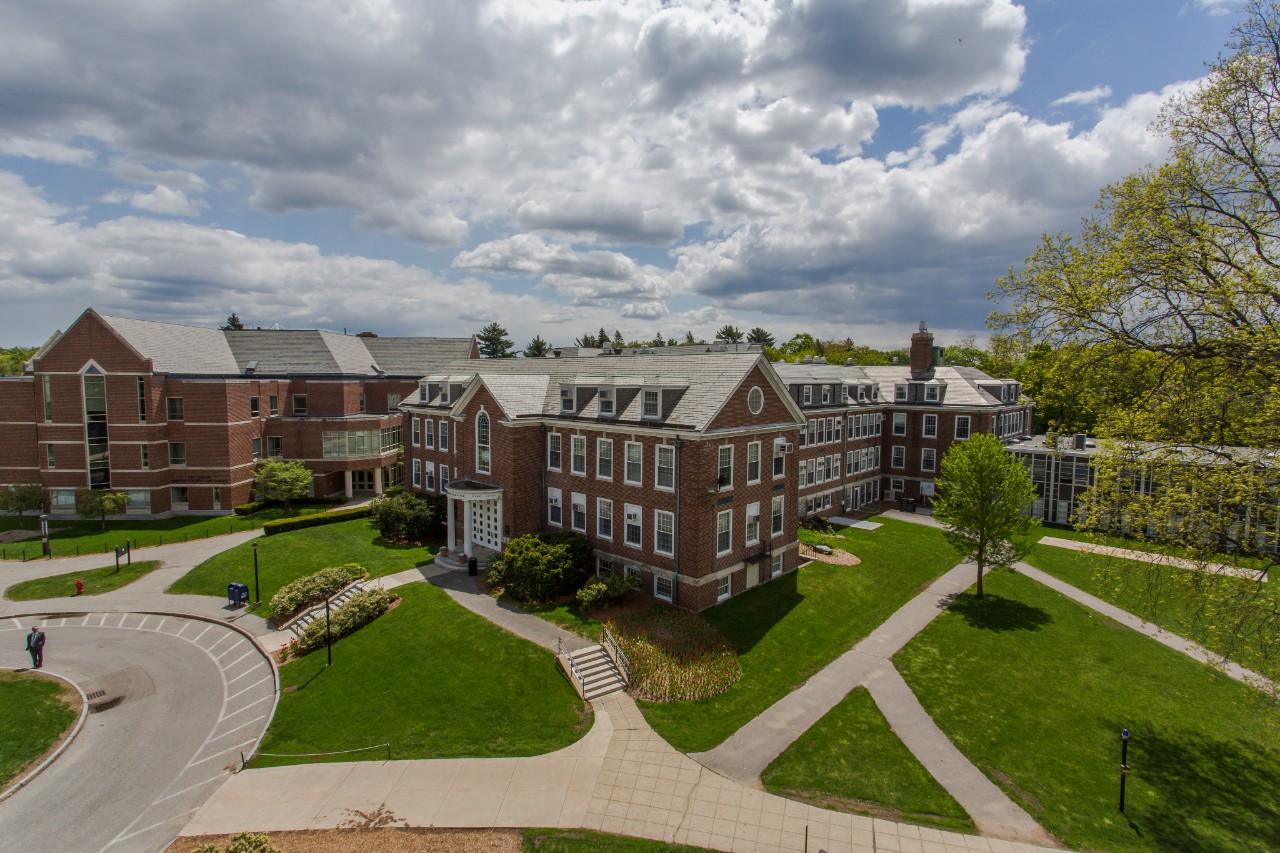
Located off Centre Street in Newton, the Newton Campus is the location of the Boston College Law School, several undergraduate residence halls, and the home of the Boston College Alumni Association.
The site is the original location of the Newton College of the Sacred Heart, a small college for women chartered in 1946. The college was staffed by members of the Society of the Sacred Heart, a French order of nuns founded in 1800.
In June 1974, Newton College was joined to Boston College by an agreement between the trustees of the two institutions. Boston College thereby acquired a new campus with a number of handsome Georgian buildings standing in a park-like estate of over 40 acres of land. A free shuttle bus regularly travels the mile and a half between the Chestnut Hill and the Newton campuses.
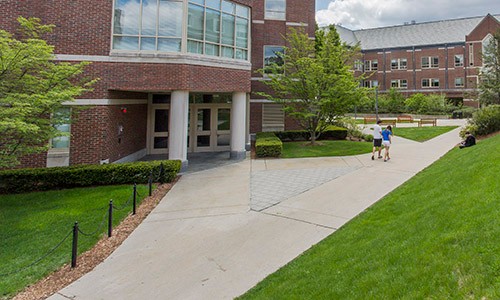
As one enters the Newton Campus from Centre Street, directly on the left is the Boston College Law School. In 1975, the school moved from its location in St. Thomas More Hall to more-spacious facilities on the Newton Campus.
The first building is the four-story Boston College Law Library, which opened in 1996 at a cost of $16.4 million. Housed in an attractive red-brick structure, the library provides a technologically advanced environment for study and research for as many as 560 people.
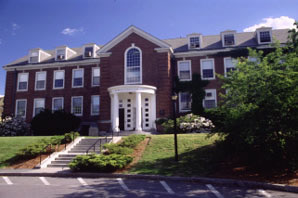
Immediately adjoining the Law Library is the five-story main Law School building, Stuart House; it is named for Sr. Janet Erskine Stuart, RSCJ, sixth Superior General of the Society of the Sacred Heart. Stuart House provides academic, administrative, and service facilities, including a 450-seat dining hall. The Smith Wing of Stuart House contains offices for faculty and for student organizations, as well as the Law School bookstore.
The East Wing, with its soaring atrium entry, includes classrooms as well as faculty and administrative offices. It also houses the John J. and Mary Daly Curtin Public Interest Center, named for John J. Curtin, Jr. ('57), past president of the American Bar Association and the Boston Bar Association. With dataports built into desktops, the East Wing has earned the Boston College Law School the reputation of being one of the "most wired" law schools in the country.
The west wing of Stuart House is called the Kenny-Cottle Wing, named for Sr. Eleanor Sampson Kenny, RSCJ, first president of Newton College; and Mrs. Edgar G. Cottle, benefactor of the college. Originally this part of the building was used as the college library. With the completion of the new Law School Library in 1996, this wing is being renovated for use as dining and recreational facilities.
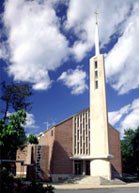
Directly across from Stuart House is the Chapel of the Most Blessed Trinity. Built in 1962, it was designed by Eugene Kennedy of Maginnis, Walsh, and Kennedy, the firm that designed or renovated all the campus buildings.
The chapel's interior wall panels are of red oak, as are the choir stalls; the altar and predella are of Botticino marble. The seating capacity of the chapel is 900, with an assembly hall in the basement that was later changed into a reading–study room for undergraduate residents of the Newton Campus.
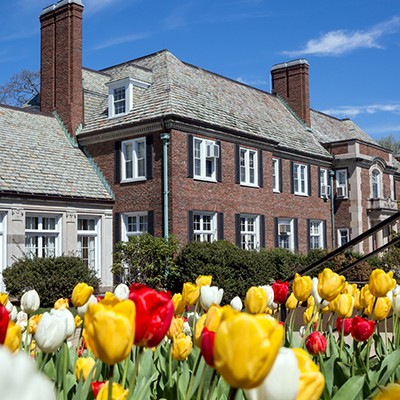
To the left of Trinity Chapel is Barat House, named for St. Madeleine Sophie Barat, RSCJ, founder of the Society of the Sacred Heart. Built in Georgian red brick by the Schrafft family in 1924, it served as the original college building. Presently it includes offices for alumni relations and development.
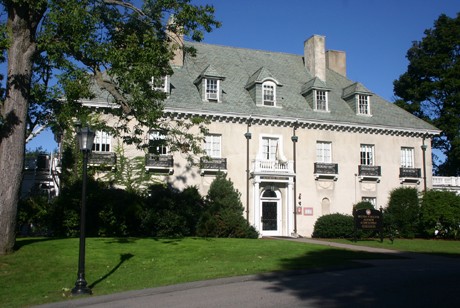
Across the Newton Campus, facing Centre Street, is Alumni House, principal location for the Boston College Alumni Association. Originally the residence of the Harriman family, for a time the building served as the library for Newton College. In 1967 it was renamed in honor of Roger Lowell Putnam, a benefactor of the college, and used for studios and classrooms for the Fine Arts Department.
In 1990, the entire residence was beautifully renovated. It then became the new home of the Boston College Alumni Association, which moved to the Newton Campus from its original location on Commonwealth Avenue.

